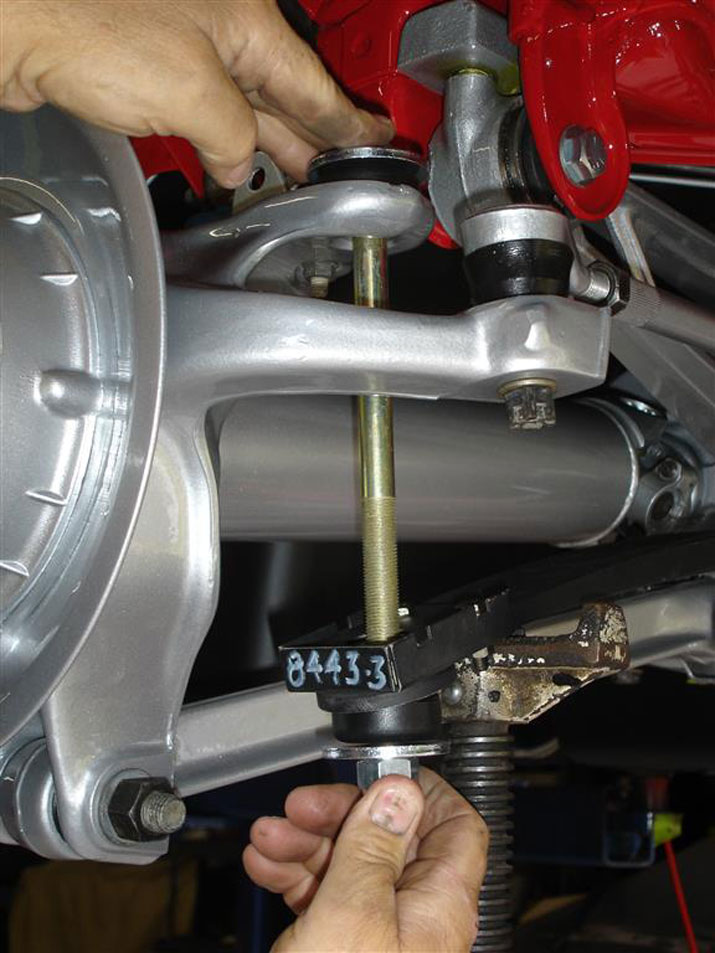— Dirt Wheels Magazine Pit Stop —
You may have a quad or UTV that allows you to adjust the camber and caster of the front end. You usually find these types of adjustable pieces on aftermarket A-arms, but rarely on OEM equipment. There are several aftermarket A-arm companies that offer camber- and caster-adjustable A-arms. Houser has Slicast A-arms, Teixeira Tech offers adjustability in their arms, while Walsh Race Craft and Roll Design, too, have adjustability. Camber and caster adjustments drastically affect the machine’s handling. Camber is how much the top of the tire is in towards the A-arms or to the outside. Caster is an adjustment that moves the angle of the knuckles forward and backward. Both camber and caster affect the way the machine handles in corners or high-speed sections. If your machine has aftermarket A-arms with camber and caster adjustability, here is how to measure and adjust them.
2. On these Houser Racing Slicast long-travel A-arms, it has a simple setup to change the camber and caster of the front end. Loosen either nut and tighten the other nut, which will move the tire in or out.

4. The Slicast (caster adjustment) is so simple to use it’s scary. By turning the Slicast wheel to different degrees, you can achieve a great setting for whatever you’re looking for. Teixeira Tech also has a simple design that’s easy as loosening the top bolts and moving it through the notched opening on the top A-arm. Having the caster adjustment towards the rear of the quad will give it the most stability during high-speed riding. Having it all the way forward will help it corner quickly, but it will also make the front end feel twitchy and unpredictable. Again, all of these adjustments are rider preference. The Slicast is only found on Houser Racing A-arms, but the measurements will remain the same across the board for all the other brands. Once you have the correct settings on camber and caster on both front tires, go ahead and tighten the nuts to the correct torque setting. Your machine should now be ready to conquer any type of terrain you are riding on and now do it better!
Adjust camber & casterAftermarket A-armshow to fix your ATV
At SuperATV, we make all of our A-arms and radius arms adjustable.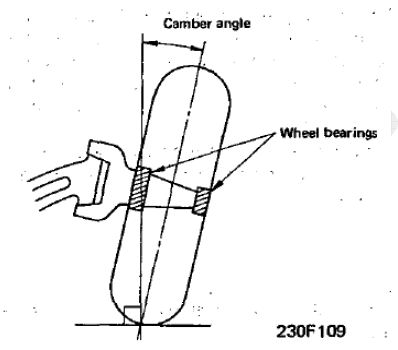 That gives you total control over your machine’s camber, toe, and caster. But why should you care? What’s the point of adjusting your suspension outside of the factory specifications?
That gives you total control over your machine’s camber, toe, and caster. But why should you care? What’s the point of adjusting your suspension outside of the factory specifications?
Let’s take a look at what camber, toe, and caster really are, how you can adjust them, and why you might want to.
What Is Camber?Camber is the inward or outward tilt of the tires when viewed from the front of of the machine. Having the wrong camber can really ruin your ride, both in terms of the way driving it feels and in terms of actually wrecking because your traction is so bad.
So what’s the difference between crappy camber and the camber you crave? Let’s take a look.
Zero camber or some negative camber can both be useful depending on your riding style. Avoid positive camber as all it’s good for is wearing out your tires, wheel bearings, and other parts.Zero camber is what you might think of as the default camber. It’s a good starting point for a typical rider.
It’s a good starting point for a typical rider.
With zero camber, your tires are straight up and down when your machine is sitting on the ground. It gives you good traction most of the time. It’s the camber you want if you’re using a Ranger or similar side-by-side for work, or plan on keeping it relatively slow for most of your rides.
However, once you start getting your speed up on the trails, zero camber starts to hold you back rather than help you.
Negative camber is when the top of your tire leans in toward the center of the vehicle. And having 2 or 3 degrees of negative camber helps immensely with traction on corners.
Here’s why: When you make a fast turn, the bottom of your outside wheels get pulled in toward the machine. If you have zero camber, that pull causes you to ride on the outside edge of your tire for the duration of the turn, which gives you much less traction.
If you have a couple degrees of negative camber, the turn pulls your tire so that the bottom is flat against the ground during the turn, which gives you maximum contact with the ground and more traction when you need it most.
For high performance machines and high speed riding, negative camber is the way to go.
You can also get negative camber if you add weight to your machine from a cooler, extra rider, or from accessories like cab enclosures and reinforced cages. So keep that in mind if negative camber isn’t something you want.
Positive camber means the top of your tires are leaning out away from the machine.
You don’t want positive camber. You might like to think of your UTV as a farm tractor’s cousin (some of you put tractor tires on it after all), but all positive camber does is give you less traction and causes your tires to wear unevenly.
You get positive camber naturally when you lift your machine and sometimes when you upgrade shocks. The main thing you should know is that you don’t want it.
How Do You Adjust Camber?The first thing you need is a set of adjustable A-arms and possibly radius arms depending on your make and model.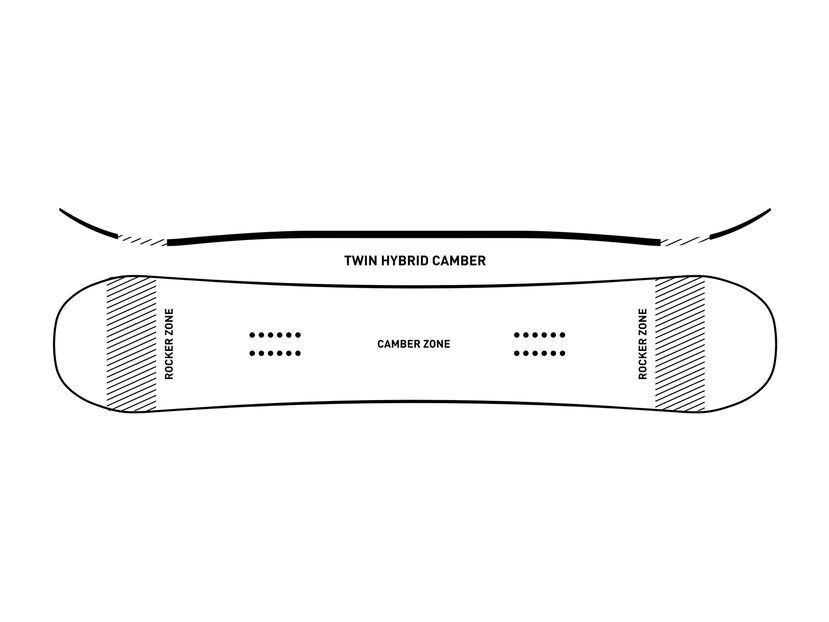 Your stock A-arms won’t do—they’re not adjustable. Luckily, adjustable parts aren’t hard to come by. All SuperATV A-arms and radius arms are adjustable and so are many other aftermarket suspension parts.
Your stock A-arms won’t do—they’re not adjustable. Luckily, adjustable parts aren’t hard to come by. All SuperATV A-arms and radius arms are adjustable and so are many other aftermarket suspension parts.
Our A-arms are set to OEM specs right out of the box, so if you’re looking for OEM camber, you’re already good to go. As you make adjustments, keep in mind that the weight of the driver will give you a little bit of negative camber naturally. It’s not always noticeable, but some choose to compensate for it with a smidge more positive camber.
This RZR has great camber. The tires are straight up and down even when it’s loaded with passengers. If this side-by-side was tuned for high speed cornering, it’d need a little more negative camber.With your machine on the ground and all your tires inflated to the same pressure, grab a carpenter’s T-square and butt it up against the side of your tire. That will tell you quickly whether you have positive (top leaning out), negative (top leaning in), or zero camber.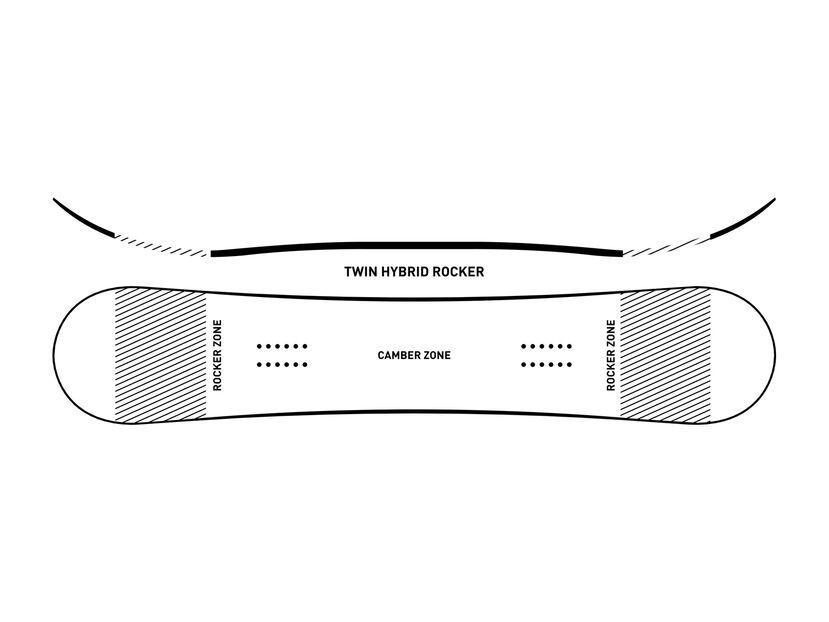 You’ll also be able to tell which way you need to make adjustments. If you use an angle gauge, you’ll know how many degrees you need to go in or out.
You’ll also be able to tell which way you need to make adjustments. If you use an angle gauge, you’ll know how many degrees you need to go in or out.
Lift your machine and remove your lower A-arms only. Lower SuperATV A-arms have adjustable pivot blocks.
Loosen the jam nuts on your pivot blocks so you can thread them in or out. If you want more negative camber, thread them out. If you need more positive camber, thread them in.
Two full turns of the pivot block changes your camber by about 1 degree. We recommend about 2 degrees of negative camber for high speed cornering.
Radius arms work similarly. Most stock and aftermarket radius arms have adjustment built in. We recommend adjusting the lowers to set your camber.
Before you go measuring your new camber, put your machine on the ground and roll it back and forth. This settles the suspension and shows you what your true riding camber will be.
Repeat these steps until you have your desired camber, then take it out for a spin!
Keep your machine on the lift and make adjustments and measurements while it’s still in the air. Just keep in mind that with the suspension at full drop, you’ll have roughly 2 degrees more positive camber than you’ll have on the ground.
Keeping it lifted allows you to install your lower A-arms up with just bolts to rapidly adjust and check easily. The only downside is that you still won’t know if you got it exactly the way you wanted until you put the machine back on the ground.
What is Toe?Toe is the direction your front tires point. If they point out, then they are toe-out. If they point in toward the machine, then they are toe-in. Toe is controlled by your tie rods.
Too much toe in or out can cause major wear on your parts, as well as make handling more difficult. That could lead to tie rod end failure, wheel bearing failure, and other issues.
Every side-by-side has different requirements for toe. Usually, they’ll come with a small amount of toe out from the factory. There’s usually not a good reason to stray from the factory settings, but if you change suspension parts or haven’t checked your toe in a long time, your alignment might be off.
Toe is easy to adjust and important for maximum performance. Too far out and your front end will suck down as the wheels try to separate. Too far in and your front will push up as they try to come together. Not to mention bad toe is bad for your tires and components.Make sure your tires are both inflated to the same psi, then park your front tires on a slick surface to make adjusting easier. You could use cardboard, a plastic sheet, or something similar. You’ll need a helper or a tool to hold the steering wheel straight at this point.
Loosen the jam nuts on your tie rod and turn it by hand or with a wrench if needed to thread or unthread both tie rod ends simultaneously. If you look down the side of your tire as you turn, you can line up the edge of your front wheels with your rear wheels to get them pointed straight forward.
If you look down the side of your tire as you turn, you can line up the edge of your front wheels with your rear wheels to get them pointed straight forward.
Once you straighten both wheels, take a tape measure and measure the distance between the centerline on both your tires. If you get the same measurement when you measure from the front and rear of your tires, you know you’ve got them perfectly aligned together. Make sure you roll your machine back and forth to settle your machine between each adjustment.
When you’ve confirmed that they’re both pointing the same direction, and that direction is straight ahead, you can tweak your toe if you want to. Different vehicles are built for different toe-in or out, so you’ll either need to look up your factory toe or experiment a little bit. An eighth inch in or out is about all you’d need. You can tell if your toe is too far in because it will cause your suspension to raise the front end as you drive. If it’s too far out, it will pull the front end down.
An eighth inch in or out is about all you’d need. You can tell if your toe is too far in because it will cause your suspension to raise the front end as you drive. If it’s too far out, it will pull the front end down.
If you imagine an invisible line connecting the ball joints on your hub, that’s your steering axis. The tilt of your steering axis is your caster. Good caster gives you great control. Bad caster can either make your steering rack feel like it’s filled with rocks or make it feel so squirrely that it’s difficult to stay in control.
Normally you don’t need to mess with caster, but if you get bigger tires, or just enjoy fine-tuning every aspect of your machine, you’ll want to take a look at it.
The main culprit behind bad caster is bigger tires, and here’s why:
Caster is the angle of your steering axis. Normally you don’t need to worry about it unless you get big tires and make heavy modifications. If you do, adjusting your caster can make your handling feel better and more stable.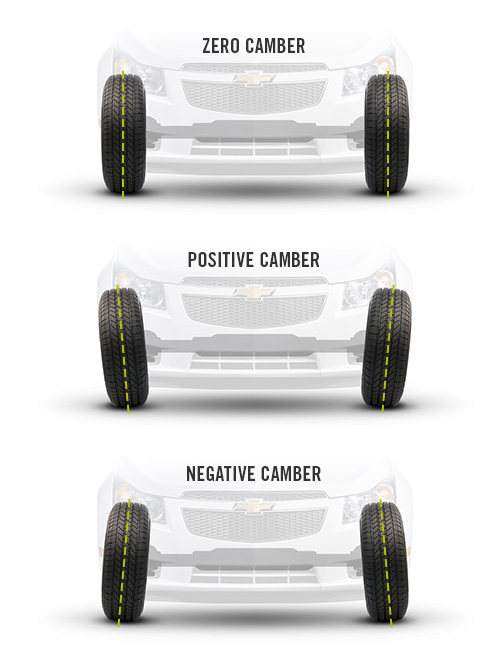
The upper and lower ball joints on your vehicle are never straight up and down. The upper is always a few inches behind the lower. This is super important because it means that when you turn, your pivot point is slightly ahead of your tire’s contact patch (the part of the tire that actually touches the ground).
That makes the ground pull your tire backwards and your wheels tilt over when you turn. That’s what causes your tires to straighten out when you let go of the steering wheel.
The angle between your steering axis and your contact patch dictates the way your vehicle handles more than anything else. If your steering axis is flatter, your wheels will be harder to turn, but you’ll have more stability. If it’s more straight up and down, it’ll be easier to turn, which will require more work from the driver to keep things stable. Larger tires really throw it out of whack.
Bigger tires increase the distance between your contact patch and your steering axis, which makes your wheels harder to turn.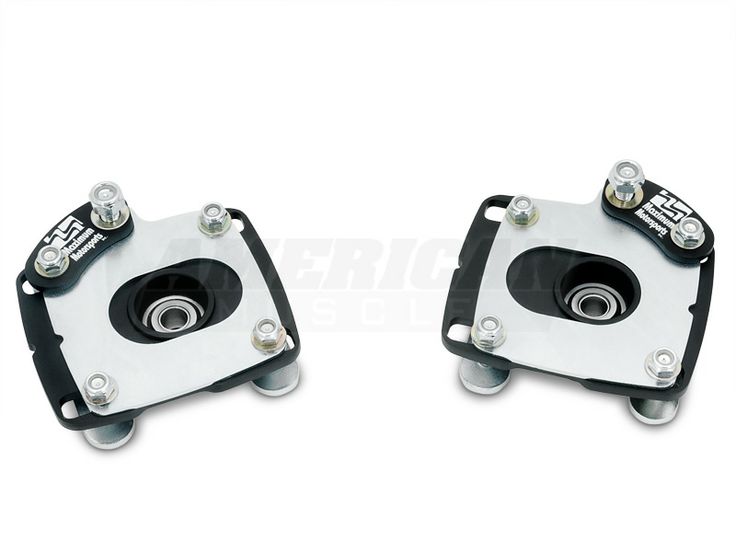 So when you upgraded your machine to some monster 40” tires, maybe it wasn’t just the weight that made them harder to turn, but rather your caster.
So when you upgraded your machine to some monster 40” tires, maybe it wasn’t just the weight that made them harder to turn, but rather your caster.
Even with bigger tires, you should worry about your camber and toe before you worry about your caster. It’s the last thing you need to worry about when you’re adjusting your alignment.
Make sure your tires are both inflated to the same psi, then lift your machine.
If you feel like a big vehicle like this 4-seater RZR is too hard to handle, adjusting your caster can help. Just be careful, you can easily make things worse if you overdo it.You have to remove your lower A-arms in order to make adjustments. SuperATV always puts the adjustable pivot blocks on the lower arms. Other brands may have their adjustment located elsewhere.
Thread the front or rear pivot block in or out 1 or 2 turns. Threading the front pivot block in, or the rear pivot block out, will make your steering axis flatter and give you more stability. Doing the opposite will make your steering axis more straight up and down, which will make steering easier. A few degrees makes a huge difference, so start with small changes. Make sure both sides have identical caster.
Threading the front pivot block in, or the rear pivot block out, will make your steering axis flatter and give you more stability. Doing the opposite will make your steering axis more straight up and down, which will make steering easier. A few degrees makes a huge difference, so start with small changes. Make sure both sides have identical caster.
Reinstall your lower A-arms and roll the machine back and forth to settle your suspension.
Take it for a test drive! It’s hard to say exactly what you should set it to—every machine is different and has a different feel. So drive it, see how it feels, and make more changes as needed.
Get Adjusted!Getting everything adjusted just right gives you a smoother ride, better control, and longer lasting components. So don’t skip it! Keep your eye on changes to your alignment so you can proactively maintain your machine. And if your alignment is off, be sure to make sure your ball joints, tie rod ends, or other suspension components aren’t wore out.
The point: keep everything in good shape and you’ll have a good ride!
So, in a rut, the steering wheel rips out of your hands, when driving straight the ATV goes to the right or left, you notice uneven tire wear or you see that one or both wheels sharply go to the side with the steering wheel set straight - all these are clear signs that that it's time for toe and camber adjustment .
It should be noted that on some ATVs only the convergence is regulated, and the camber is set by the manufacturer.
Getting rid of the problem.
There are many ways, we will try to talk about the most obvious and intuitive.
Which nuts to turn?
#1 Loosen nuts; No. 2 Toe adjustment (turn the tie rod itself with a wrench; No. 3 camber adjustment;
Attention! You do not need to hang the ATV, adjust it on a flat surface without holes and hills, set the steering wheel straight.
Visually we try to evaluate the wheels in front, look at the eye, it will immediately become clear which wheel goes to the side more and which one less. Sometimes adjusting by eye is enough, if we want everything according to science, then we move on.
Method 1
On the rim, on the very edge from the inside, on both sides of each wheel, near the shoulder, we make marks with a marker so that the marks are parallel to the ground.
With the help of a simple ruler, we set the convergence, we rest the ruler against the marks and measure the front and back along the marks.
A ruler is a pipe inserted into a pipe of a larger diameter, at its ends there are L-shaped stops (curved so that the bottom of the ATV does not interfere), with which we will rest against the marks.
For convenience, we fasten the tape measure onto the ruler and look at the numbers, the shiny bolt is the lock, rested on the marks in front and fixed it, looked at the numbers and repeated the procedure on the back of the wheels.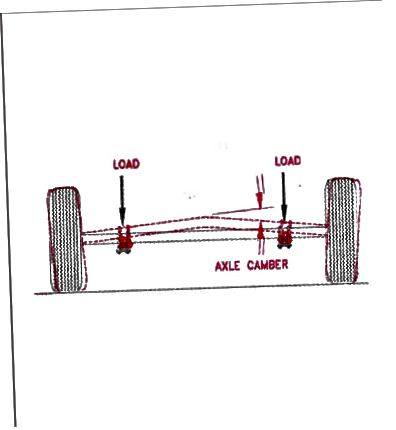
We loosen the locking nuts on the steering rods, turn the rods in one direction or another, twisted and measured a bit, realized that it was a little or a lot, we turn further. Wheel alignment is measured between the edges of the rim. The wheels should be as in the figure below, the difference between A and B should be 0-3mm (less in front and more in the back). Universal convergence is made 0 mm.
After we lock the nuts and try to drive, perhaps the steering wheel will be a little crooked, and the quad will drive smoothly. We loosen the lock nuts again and turn the rods for the same number of revolutions, thereby aligning the steering wheel, but without touching the convergence.
Nothing needs to be adjusted on the rear suspension.
Method 2
1. Set the steering wheel to straight ahead.
2. Place the stands in front of the ATV perpendicular to the rear wheels as shown.
3. Stretch the elastic band around the ATV legs so that it just touches the rear wheels lightly.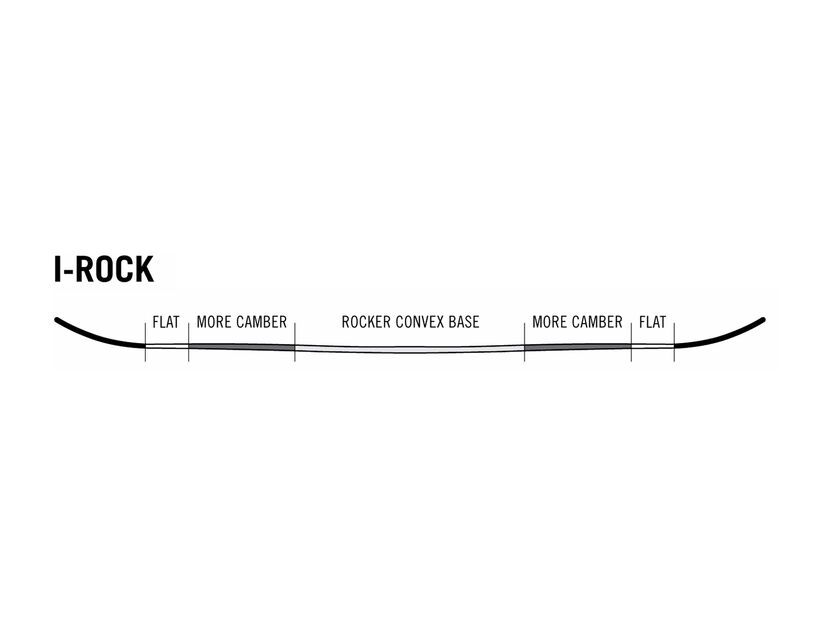
4. Measure the distance between the tensioned tape and the front and rear points on the front wheel rim. The distance to the far point on the rim should be 2 - 3 mm greater than the distance to the near point on the same rim.
You yourself could see for yourself that there is nothing complicated in adjusting the toe and camber on an ATV, and you yourself are quite capable of doing it without resorting to the services of a car service. So we put the saved money in our pocket and happy and satisfied we go for a ride.
"Carburet setting...
Wheel chains... "
Camber adjustment problems on an ATV are a very common problem on this type of motorcycle. And even cool ATVs "get sick" with a similar problem. This malfunction is diagnosed by the following features:
And even cool ATVs "get sick" with a similar problem. This malfunction is diagnosed by the following features:
● when turning, the steering wheel of the motorbike breaks out of the hands;
● When driving in a straight line, the ATV will turn to the right or left;
● rubber on wheels wears unevenly;
● The wheels lean noticeably to the side when the steering wheel is level.
You can adjust the camber with your own hands, or by contacting the services of professionals from a motorcycle service. In some models of ATVs, you can only change the toe with your own hands, and the camber is set during the manufacture of the vehicle, and does not change in the future.
If you want to forget about wheel alignment problems, then you have three options:
● unscrew the nuts a little to loosen them;
● adjust toe;
● Adjust the camber.
It is not necessary to hang the ATV for this work, it is best to place it on a flat surface with the handlebars straight.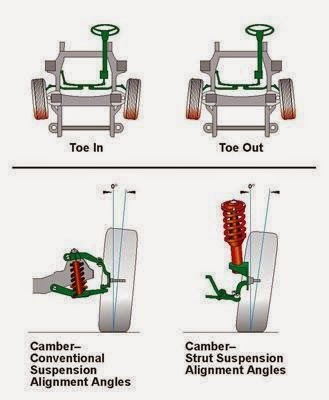 Usually, the need for camber adjustment can be identified purely visually by determining which of the front wheels of the motorcycle deviates to the side.
Usually, the need for camber adjustment can be identified purely visually by determining which of the front wheels of the motorcycle deviates to the side.
If it was not possible to correct the situation by eye, then you can try to loosen the nuts. This is done as follows:
● Use a marker to mark the wheel rims with two marks parallel to the ground;
● using a ruler, determine the amount of toe-in front and rear from the marks;
● loosen the nuts on the tie rods with a wrench;
● tighten the rods to the optimum toe-in values;
● Toe-in is measured between the edges of the ATV's rims and should be between zero and three millimeters.
Now you need to check if the adjustment has been made correctly. For this purpose, you need to fasten the nuts, and try to drive a quad bike a little. Sometimes it happens that the motorbike moves smoothly, but the steering wheel looks to the side. To fix this, you need to loosen the nuts again, and scroll the corresponding number of turns of the thrust, trying to give the steering wheel a level position.
If the above method does not suit you, there is an alternative. To adjust the camber on an ATV, follow these steps:
● set the vehicle's steering wheel straight;
● place the racks in front of the motorbike in a perpendicular position relative to the rear wheels;
● Wrap the ATV with elastic so that it barely touches the rear wheels;
● measure the distance from the tape to the rear and front marks on the rims. The difference between the measured distances should not exceed three millimeters.
Adjusting the camber of an ATV is not the most difficult task, and therefore every motorist can cope with it if desired.
If you do not have enough free time or skills to adjust the camber of an ATV with your own hands, then you can always contact the Dvako Moto motorcycle dealership. Highly qualified craftsmen will perform all the necessary repairs and maintenance of any type of motorcycle not only extremely quickly, but also at a very pleasant price.